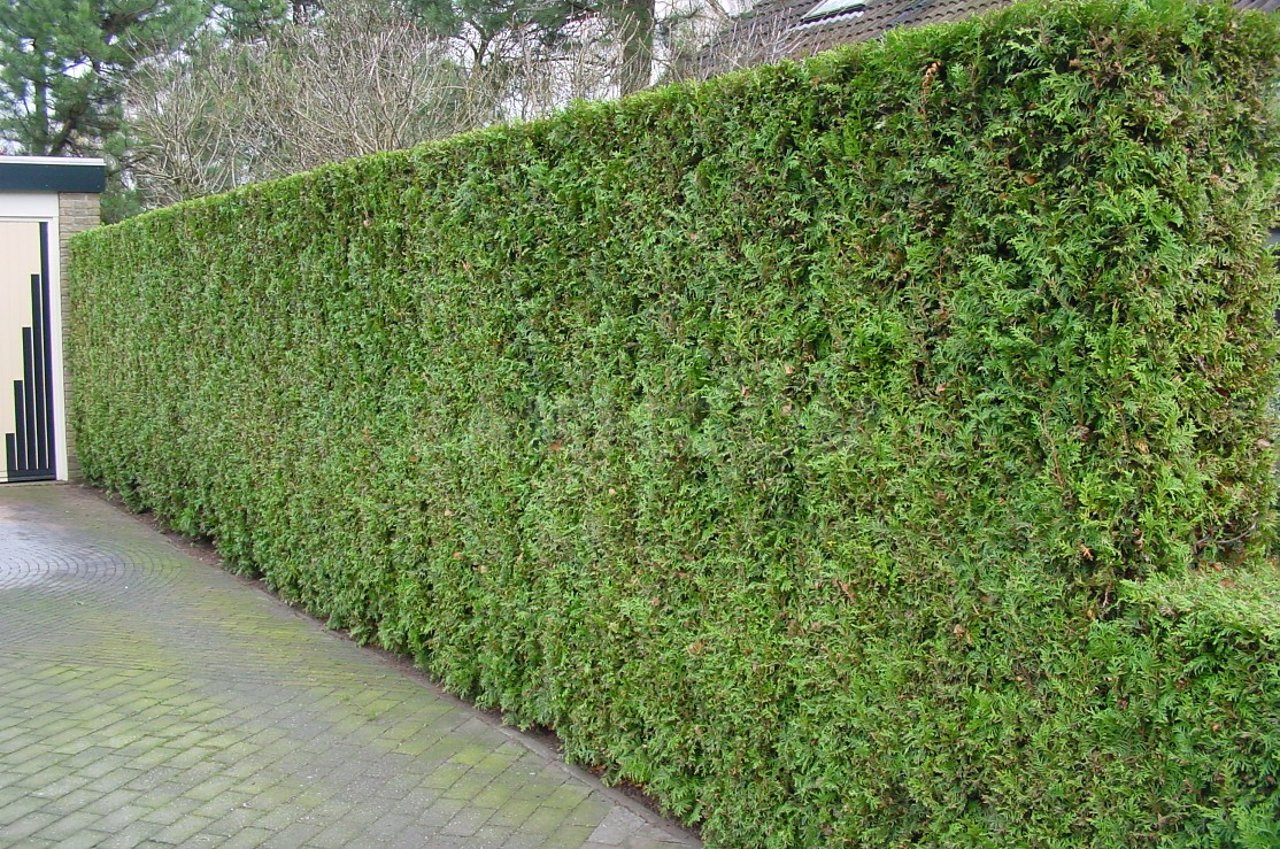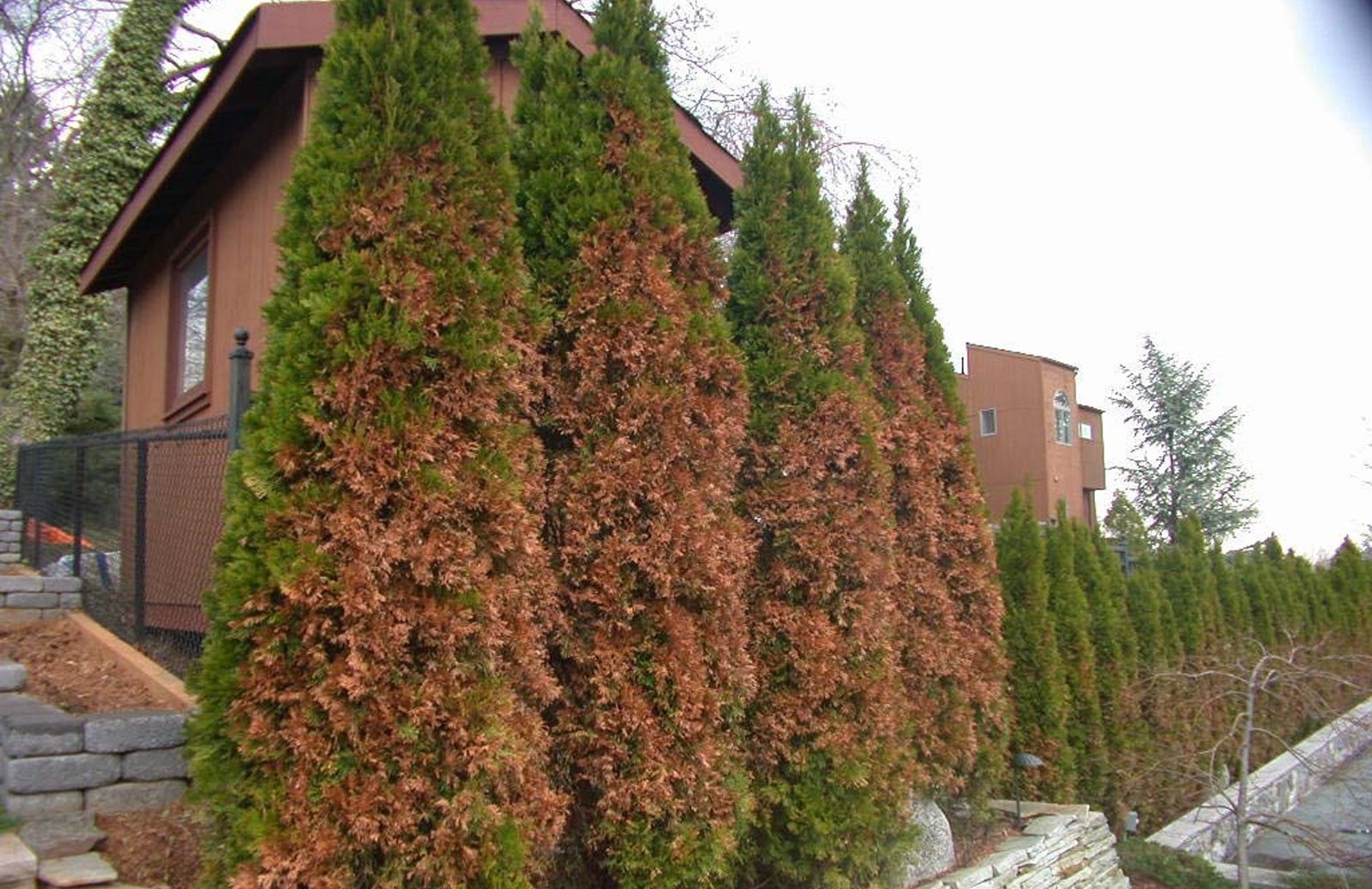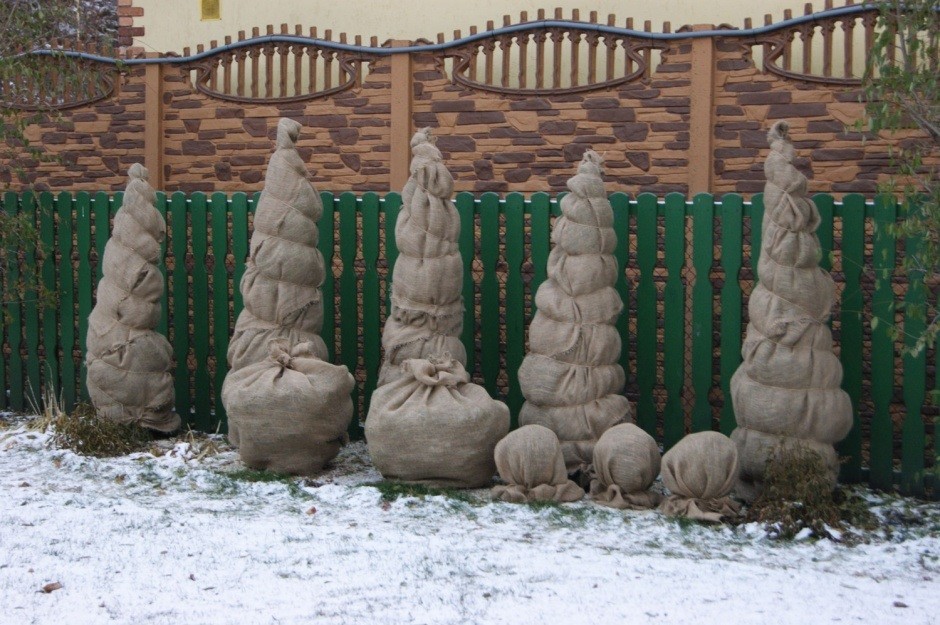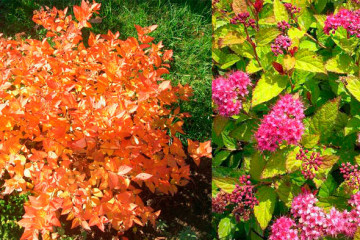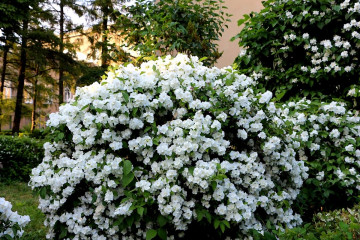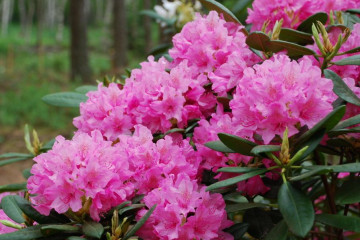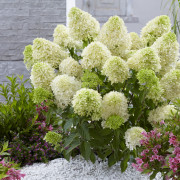Tuya Brabant - description and size, fit and care
Content:
The Brabant variety belongs to the western type of thuja. It is an evergreen coniferous tree widely used in ornamental horticulture around the world. Brabant is an artificially bred variety, characterized by winter hardiness and resistance to the adverse effects of the urban environment.
Thuja Brabant
The ancestor is the western thuja (Thuja occidentali), the plant can, in favorable conditions, reach a record height of 38 m, but usually does not grow above 20 m. At the same time, the annual growth is extremely small. The Barabant variety grows much faster - the annual growth is up to 30 cm in height and up to 10 cm in width. In urban areas the maximum height is up to 4 m.
Description and dimensions
Thuja belongs to long-lived conifers. In one place, it can grow up to 150 years. Climatic zones II-VII are suitable for it. The tree tolerates frosts painlessly down to -35 ° С. Thuja acquires the greatest decorativeness in a free and sunny place, but feels good in places where part of the day is in the shade.
In the middle of spring, the tree blooms. Then small (up to 1 cm in length) oblong brown cones are tied. Inside are seeds that can be used for propagation. Brabant is a hardy variety that grows even in severe frosty winters. There is also no exactingness to the soil, therefore, it is grown with equal success on alumina, black soil, sandy loam and other soils.
Thuja "Golden Brabant" is on sale. This is a special variety with a yellow-golden shade of needles. Against the background of a snow-covered garden, the tree looks truly amazing and festive, pleasing the eye on New Year's holidays. Throughout the year, the color of the needles remains unchanged - this is its most attractive characteristic.
Thuja western Brabant - height and diameter of an adult plant
According to the description of the producers, the tree is capable of stretching up to 20 m in height and up to 4 m during its life. The crown has a natural pyramidal shape, but it can be easily changed by shearing without much damage to the plant. In a thickened planting, thuja tends to grow upward, and not in breadth.
Thuja Brabant hedge
This variety is ideal for obtaining living fences. Young seedlings give up to half a meter of growth per year. To achieve a high density and fluffiness of the crown, it must be trimmed twice per season. A truly impenetrable hedge is obtained with a high planting density - 1 seedling per linear meter. A multi-row landing is made with the same interval.
After 2-3 years, the "living fence" will cease to shine through, creating a very dense shadow. Compared to other varieties, Brabant does not change the color of the needles all year round. For this quality, it is highly valued in private suburban buildings and in city parks.
Pruning thuja Brabant
To form the crown, use a pruner. The first pruning is performed immediately after transplanting the seedling into open ground - in March.The second is carried out six months later. This is how a dense and lush crown is obtained. If in summer the shape of individual seedlings becomes too loose with prominent individual branches, then additional correction is made.
When performing work, follow the recommendations:
- Remove all broken, damaged branches.
- The branches are shortened by no more than a third. At the same time, they tend to give the tree a certain shape - a cube, a parallelepiped, a ball, a pyramid.
- A cloudy day is chosen for work in order to prevent burns of shoots injured by pruning.
At the end, be sure to water all the seedlings.
How quickly thuja grows
Young seedlings grow fastest in the first 5 years of life. At this time, the annual growth reaches half a meter. In the future, growth slows down, the trees grow only 30 cm per year. After 15-20 years, the tree can completely stop, or its growth becomes almost imperceptible.
Thuja Brabant root system
For all thujas, a horizontal arrangement of roots is typical, which does not go too deep into the ground. During growing in containers, the root system becomes compact.
Thuja Brabant - planting and care
You should buy seedlings in reliable retail outlets and nurseries. The fact is that thuja reacts extremely slowly to adverse conditions, but it does so without fail. As a result, it may turn out that a damaged seedling will die after transplanting, although it was damaged in the store. It is difficult for a non-specialist to distinguish a diseased plant visually, but a too cheap price tag should alert you.
High-quality planting material is easy to recognize. The needles are elastic and have a bright color. Brown and yellow tips are a clear sign of illness. Healthy root tips are white, 1-3 mm in diameter. The soil in the container is moist. It is best to purchase seedlings up to 1 m high, but not lower than 20 cm.
How to plant thuja Brabant
The optimal time to plant a thuja seedling in a permanent place in open ground depends on its type:
- with a closed root system - April or October;
- open - March-April.
A planting hole is dug with a depth of 70-75 cm and a diameter of about 1 m. If we are talking about planting a hedge, then they dig a trench of the same depth. The bottom is sprinkled with a layer of 10 cm of sand or expanded clay for better drainage. A mound of fertile soil is poured in the center, on top of which the roots of the seedling are spread. Fill the hole with a prepared soil mixture, trying not to tamp too much, since the roots need air flow.
So that during irrigation the water does not spread to the sides, a roller 20 cm high is built from the soil along the planting trench or around the pit for a single planting.
Immediately after transplanting, the seedlings are watered abundantly, adding 30-50 g of nitroammophoska to each tree. The trunks are sprinkled with a layer of mulch to protect against drying out of the soil and curb weed growth.
Site selection and soil preparation
Partial shade is ideal lighting for young trees. This can be achieved by planting them along tall buildings that provide shade during part of the day. It is not worth planting young thuja next to tall and old trees, because the shading will turn out to be too strong.
The soil is poured into the planting pits ready-made, suitable for conifers, or the soil is mixed independently. To do this, take 3 parts of sod land, add 1 part of sand and peat. The structure should be loose and light, the ideal acidity is pH 4–5.5.
Mandatory plant care
Among the activities required for young seedlings, the most important are the following:
- Watering. Carry out in 3-4 days, at the rate of up to 10 liters of water for each seedling.
- Loosening. It is necessary, but to a depth of no more than 10 cm. A layer of mulch from peat or sawdust will allow to do without loosening.
- Weed removal. It is important to remove weeds around the thuja immediately, especially with deep roots.
If the seedling looks too loose, then immediately after planting it must be trimmed, removing damaged branches and setting the direction of crown growth.
Typical diseases and pests
It is fairly easy to tell if a plant is under stress from illness or mishandling. For example, yellowing of a tree, especially on one side, may indicate that pets urine gets on the roots. Often, the roots attack fungal infections, destroying the symbionts of the ephedra. This is evidenced by the bark of a tree that easily falls through when pressed against the trunk.
Pests such as wireworms and larvae of weevils can cause great damage to thuja. Liming of the soil helps with wireworms, and specialized insecticides for weevils. To heal a sick tree, they take a solution of Bordeaux liquid and process the needles.
There are other problems as well:
- Phytophthora. The root system suffers first, and then the fungus spreads to the needles. Thuja quickly fades, the needles become unpleasant sticky and gray in color. The cause is excessive watering or waterlogging of the soil. For treatment, they are treated with fungicides.
- Fusarium. Because of it, the needles acquire a brown color. To cope with the disease, the affected shoots are removed, and the tree is treated with Fundazol solution.
- Rust. Usually appears in March. Affected needles darken and fall off. Treatment with copper-based fungicides helps.
- Thuya aphids. It is easy to notice it by wiggling on the branches. Severely affected shoots dry quickly. From aphids are treated with "Karbofos".
Thuja Brabant - needles turn yellow
Not only pests and diseases can harm a young tree. Sometimes the reason for the loss of an attractive appearance is a deficiency of microelements. At the same time, it is worth adding fertilizers very carefully. Excess will cause the tips of the shoots to dry out.
If the needles acquire a reddish-purple hue, this indicates a lack of phosphorus. Nitrophoska, ammophos or other phosphorus-containing composition is introduced.
Yellowing of the needles indicates a lack of iron, and its pale appearance indicates a deficiency of nitrogen. Top dressing is carried out during watering, following the recommendations of the fertilizer manufacturer.
Preparing for winter
Before wintering, the seedlings are covered with burlap, spruce branches, non-woven material, and kraft paper. The crown is completely covered and fixed with twine. With adult plants, you no longer need to make so much effort, they winter safely without shelter.
Mulching helps prevent root damage. For these purposes, needles, peat, crushed shoots of coniferous and deciduous trees are excellent. In the spring, it is recommended to rake and burn the old mulch, and instead pour a layer of sawdust or pine needles.
Crown formation
Thuja pruning is of great importance for the plant itself. If you do not do it, the crown becomes loose, untidy. Yellowed or damaged branches that have not been removed in time can become a source of disease or pest damage to the entire tree.
It is recommended to carry out the first pruning when the average daily temperature rises to +10 ° C. Instead of the shoot cut by a third, a violent new growth of lateral shoots is formed, quickly filling the gaps in the crown.If the top of the tree is bent in winter due to strong wind or the severity of snow, then to correct the situation, it is simply cut off, giving the crown a rectangular shape.
If there are only a few thujas on the site, then they are molded with an ordinary pruner or garden shears. A power tool may be required to form the correct geometry of a long hedge.
Tuya Smaragd and Brabant - differences
Both will cost approximately the same amount when buying - the difference is insignificant, but it is worth giving preference to one or another variety, based on their key differences. Which is better - thuja Smaragd or Brabant - it is necessary to decide based on the conditions at a particular site.
The table will help to compare:
| Brabant | Emerald | |
| Annual growth | Up to 50 cm | Up to 20 cm |
| Pruning | 2 times per year | Once a year |
| Photophilousness | Photophilous | Shade tolerant |
| Frost resistance | Up to -35 ° С | Up to -40 ° С |
| Planting density for hedges | 1m | 80 cm |
| Life span | Up to 150 years old | Up to 110-130 years old |
Features of growing thuja Brabant: planting, care, use in landscape design
In park and garden plantings, thuja is usually combined with other conifers, preferring species and color contrasts. Good neighbors for Brabant are cypress, spruce, larch, open and globular junipers, and microbiota.
If we are talking about creating a hedge, then they are of two types:
- Free-growing. Gaps remain between the trees, and their crown is cut in the form of regular geometric shapes, the same or different.
- Shorn. Planting is carried out with maximum density in order to get a dense wall with a height of about 1.5 m in 2-3 years. The trimming type is performed without highlighting each individual plant. Due to the interweaving of branches, neighboring trees literally turn into an impassable wall. It is noteworthy that over the years, the trunks do not become bare, which is especially appreciated in landscape design.
Given that watering and periodic feeding, as well as cutting are the main measures for caring for hedges, the only obstacle to wider distribution is the high price of varietal seedlings. On average, 1 tree up to 1 m high will cost 1.5 thousand rubles.
Thuja Brabant is a beautiful coniferous tree that is planted in single and group plantings. Its unpretentiousness and high vitality, long lifespan and good susceptibility to formative pruning have made it very popular in all regions. Every year, a hedge or a single tapeworm will look even better.


